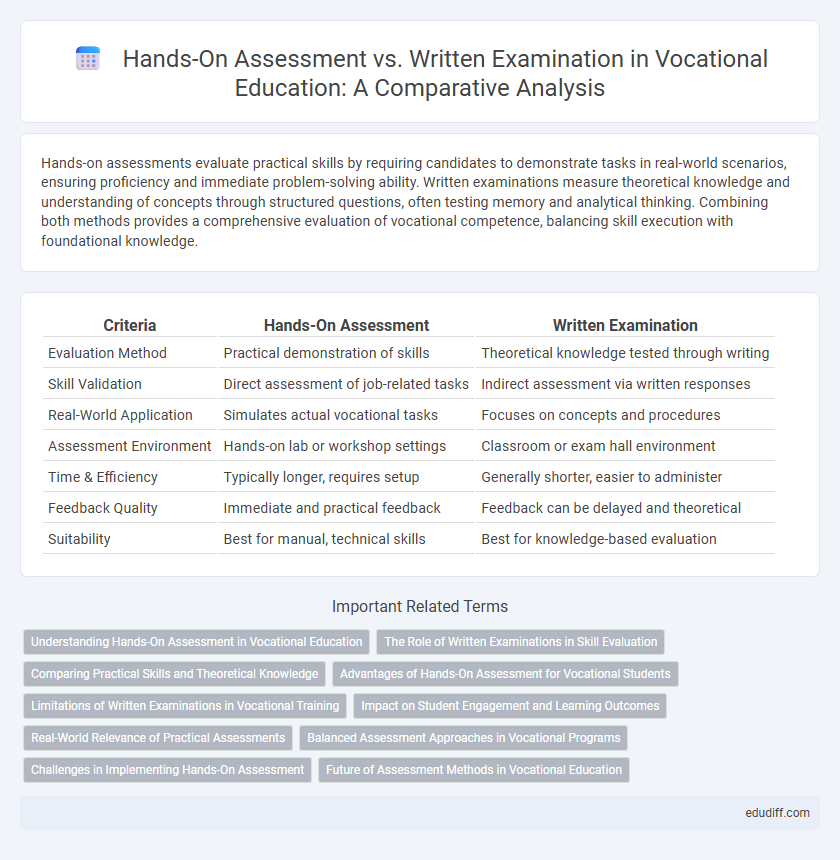Hands-on assessments evaluate practical skills by requiring candidates to demonstrate tasks in real-world scenarios, ensuring proficiency and immediate problem-solving ability. Written examinations measure theoretical knowledge and understanding of concepts through structured questions, often testing memory and analytical thinking. Combining both methods provides a comprehensive evaluation of vocational competence, balancing skill execution with foundational knowledge.
Table of Comparison
| Criteria | Hands-On Assessment | Written Examination |
|---|---|---|
| Evaluation Method | Practical demonstration of skills | Theoretical knowledge tested through writing |
| Skill Validation | Direct assessment of job-related tasks | Indirect assessment via written responses |
| Real-World Application | Simulates actual vocational tasks | Focuses on concepts and procedures |
| Assessment Environment | Hands-on lab or workshop settings | Classroom or exam hall environment |
| Time & Efficiency | Typically longer, requires setup | Generally shorter, easier to administer |
| Feedback Quality | Immediate and practical feedback | Feedback can be delayed and theoretical |
| Suitability | Best for manual, technical skills | Best for knowledge-based evaluation |
Understanding Hands-On Assessment in Vocational Education
Hands-On Assessment in vocational education evaluates practical skills by requiring students to perform specific tasks or demonstrate competencies directly related to their trade or profession. This method emphasizes real-world application and critical problem-solving abilities, offering a more accurate measure of a student's capability than traditional written examinations. By simulating workplace scenarios, hands-on assessments ensure learners are job-ready and proficient in essential vocational skills.
The Role of Written Examinations in Skill Evaluation
Written examinations in vocational training serve as a critical tool for assessing theoretical knowledge and comprehension of core concepts essential to specific trades. They enable systematic evaluation of a candidate's understanding of safety protocols, technical standards, and regulatory requirements, which may not be directly observable through hands-on assessments. By complementing practical tests, written exams ensure a comprehensive measurement of both cognitive skills and procedural knowledge necessary for proficient job performance.
Comparing Practical Skills and Theoretical Knowledge
Hands-on assessments directly measure vocational learners' practical skills by evaluating their ability to perform tasks in real-time, ensuring proficiency in job-specific techniques. Written examinations primarily test theoretical knowledge, assessing understanding of concepts, procedures, and safety protocols essential for vocational competence. Combining both methods offers a comprehensive evaluation, balancing skill application with foundational understanding.
Advantages of Hands-On Assessment for Vocational Students
Hands-on assessment offers vocational students practical skill evaluation that mirrors real-world job tasks, enhancing their readiness for employment. This method allows instructors to directly observe competencies such as tool handling, problem-solving, and procedural expertise, ensuring a comprehensive skill validation. It fosters active learning and immediate feedback, which significantly improves skill retention and confidence in vocational disciplines.
Limitations of Written Examinations in Vocational Training
Written examinations in vocational training often fail to accurately measure practical skills and hands-on competencies crucial for industry readiness. They tend to emphasize theoretical knowledge over real-world application, limiting the ability to assess problem-solving and technical proficiency in dynamic work environments. Consequently, reliance on written assessments can result in a gap between certification outcomes and actual vocational performance.
Impact on Student Engagement and Learning Outcomes
Hands-on assessments significantly enhance student engagement by providing practical experience and active participation, which leads to deeper understanding and skill retention in vocational training. Written examinations primarily test theoretical knowledge but may not fully capture a student's ability to apply skills in real-world contexts, potentially limiting the demonstration of practical competencies. Combining both methods can optimize learning outcomes by balancing knowledge assessment with skill application, fostering comprehensive vocational proficiency.
Real-World Relevance of Practical Assessments
Hands-on assessments provide direct evaluation of skills by simulating real-world vocational tasks, ensuring candidates demonstrate practical competence beyond theoretical knowledge. These assessments reflect daily job responsibilities, making them more effective in predicting job performance compared to written examinations. Incorporating practical evaluations aligns training outcomes with industry standards and employer expectations.
Balanced Assessment Approaches in Vocational Programs
Balanced assessment approaches in vocational programs combine hands-on assessments and written examinations to comprehensively evaluate a candidate's practical skills and theoretical knowledge. Hands-on assessments validate the ability to perform job-specific tasks in realistic settings, while written examinations measure understanding of underlying principles and safety protocols. Integrating both methods ensures a holistic appraisal of competencies, enhancing the reliability and relevance of vocational qualifications.
Challenges in Implementing Hands-On Assessment
Hands-on assessment in vocational training faces challenges such as resource intensity, requiring specialized equipment and trained assessors to simulate real-world tasks authentically. Scheduling and consistent evaluation pose difficulties, as varying performance conditions may affect fairness and reliability compared to standardized written examinations. Ensuring safety protocols during practical tests adds another layer of complexity, potentially limiting the scope and frequency of hands-on assessments.
Future of Assessment Methods in Vocational Education
Hands-on assessments in vocational education provide practical skill validation that aligns closely with industry requirements, while written examinations primarily test theoretical knowledge. Future assessment methods are likely to integrate digital simulations and real-time performance tracking to create a comprehensive evaluation framework. Emerging technologies such as virtual reality and AI-driven analytics will enhance the accuracy and relevance of vocational assessments, promoting competency-based learning outcomes.
Hands-On Assessment vs Written Examination Infographic

 edudiff.com
edudiff.com